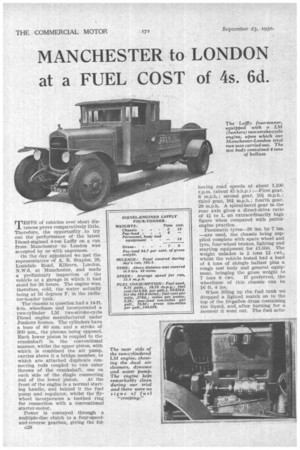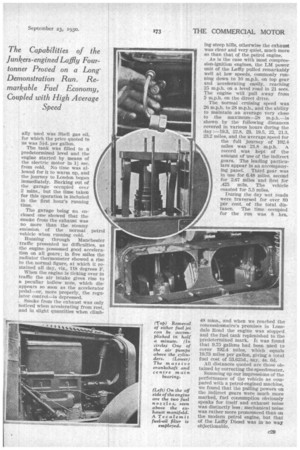MANCHESTER to LONDON at a FUEL COST of 4s. 6d.
Page 50

Page 51

If you've noticed an error in this article please click here to report it so we can fix it.
The Capabilities of the Junkers-engined Lajjly Fourtonner Proved on a Long. Demonstration Run. Remarkable Fuel Economy, Coupled with High Average
Speed
TESTS of vehicles over short dis1.. tances prove comparatively little. Therefore, the opportunity to try out the performance of the latest Diesel-engined 4-ton Laffly on a run from Manchester 'to London was accepted by us with eagerness.
On the day• appointed we met the representative of A. B. Staples, 26, Lonsdale Road, Kilburn, London, N.W.6, at Manchester, and made a preliminary inspection of the vehicle at a garage in which it had stood for 36 hours. The engine was, therefore,' cold; the water actually being at 50 degrees F. in the radiator-header tank.
The chassis in question had a 14-ft. 9-in, wheelbase and incorporated a two-cylinder LM two-stroke-cycle Diesel engine manufactured under Junkers licence. The cylinders have a bore of 80 mm. and a stroke of 300 mm,, the pistons being opposed. Each lower piston is coupled to the crankshaft in the conventional manner, whilst the upper piston, with which is -combined the air pump, carries above it a bridge member, to which are attached duplicate connecting rods coupled to two outer throws of the crankshaft, one on each side of the gingle connecting
rod of the lower piston. At the front of the engine is a normal starting handle, and behind it the fuel pump and regulator, whilst the flywheel incorporates a toothed ring for connection with a conventional starter-motor.
Power is conveyed through a multiple-disc clutch to a four-speedand-reverse gearbox, giving the fol c28 lowing road speeds at about 1,100 r.p.m. (about 43 b.h.p.) :—First gear, 6 m.p.h..; second gear, 10/ m.p.h.; third gear, 16i m.p.h.; fourth gear, 28 m.p.h. A spiral-bevel gear in the rear axle gives a direct-drive ratio of 4i to 1, an extraordinarily high figure when compared with petrolengine practice.
Pneumatic tyres-36 ins. by 7 ins. —are used, the chassis being supplied complete with spare wheel and tyre, four-wheel brakes, lighting and starting equipment for £1,050. The weight unladen is 2 tons 12 cwt., whilst the vehicle tested had a load of 4 ton.s of shingle ballast plus a rough test body and general equipment, bringing the gross weight to 7 tons 6 cwt. If preferred, the wheelbase of this chassis can be 16 ft. 4 ins.
When filling up the fuel tank we dropped a lighted match on to the top of the 10-gallon drum containing the liquid, and after burning for a moment it went out. The fuel actu ally used was Shell gas oil, for which the price quoted to us was 5id. per gallon.
The tank was filled to a predetermined level and the engine started by means of the electric motor in 11 sec. from cold. No time was allowed for it to warm up, and the journey to London began immediately. Backing out of the garage occupied over 2 mins., but the time taken for this operation is included in the first hour's running time.
The garage being an enclosed one showed that the smoke from the exhaust was no more than the steamy emission, of the normal petrol ,vehicle when running cold.
Running through Manchester traffic presented no difficulties, as the engine, possessed good acceleration on all gears; in five miles the radiator thermometer showed a rise to the. normal figure, at which it remained all day, viz., 118 degrees F.
When the engine is ticking over in traffic the air intake gives rise to a peculiar hollow note, which disappears so soon as the accelerator pedal—or, more properly, the regulator control—is depressed.
Smoke from the exhaust was only noticed when accelerating from rest, and in slight quantities when climb ing steep hilLs, otherwise the exhaust was clear and very quiet, much more so than that of the petrol engine.
As is the case with most compression-ignition engines, the LM power unit of the Laffiy pulled remarkably well at low speeds, commonly running down to 10 m.p.h. on top gear and accelerating easily, reaching
25 m.p.h. on a level road in 21 secs. The engine will pull away from 5 m.p.h. on the direct drive.
The normal cruising speed was 26 m.p.h. to 28 m.p.h., and the ability to maintain an average very close to the maximum-28 m.p.h.—is shown by the following distances covered in various hours during the day :-19.3, 22.8, 23, 19.5, 22, 21.3, 23.2 miles, and the average speed for the full journey of 192.4 miles was 21.8 m.p.h. A record was kept of the amount of use of the indirect gears. The leading particulars appear in an accompanying panel. Third gear was In use for 6.48 miles, second for 2.67 miles and first for .425 mile, The vehicle coasted for 5.5 miles.
During the day wet roads were traversed for over 80 per cent. of the total distance. The time occupied for the run was 8 hrs.
48 mins., and when we reached the concessionnaire's premises in Lonsdale Road the engine was stopped and the fuel tank replenished to the predetermined mark. It was found that 9.75 gallons had been uSed to cover 192.4 miles, which equals 19.73 miles per gallon, giving a total fuel cost of 53.625d., say, 4s. 6d.
All distances quoted are those obtained by correcting the speedometer.
Summing up our impressions of the performance of the vehicle as compared with a petrol-engined machine, we found that the pulling powers on the indirect gears were much more marked, fuel consumption obviously speaks for itself and exhaust noise was distinctly less ; mechanical noise was rather more pronounced than on the modern petrol engine, but that of the Laffiy Diesel was in no way, objectionable.












































































































